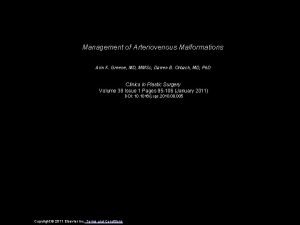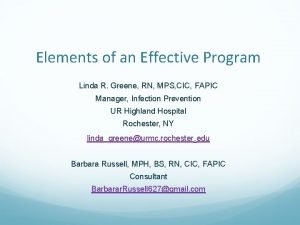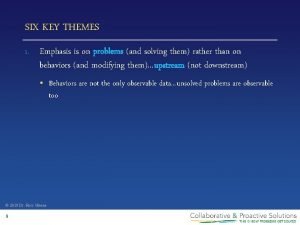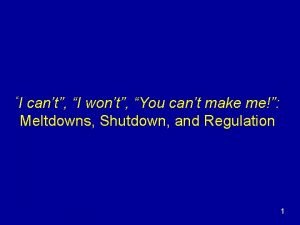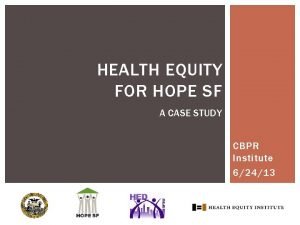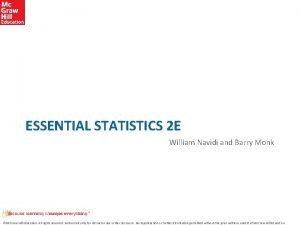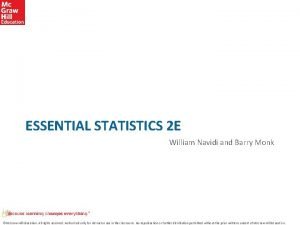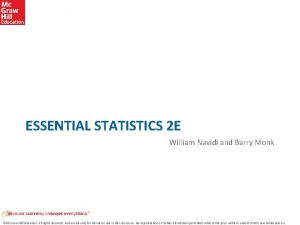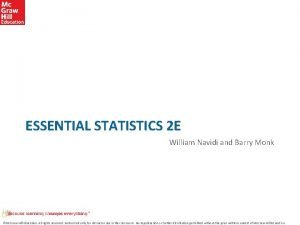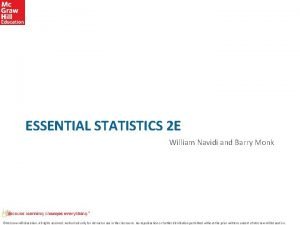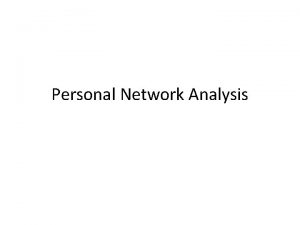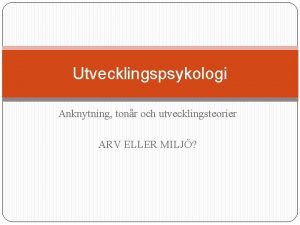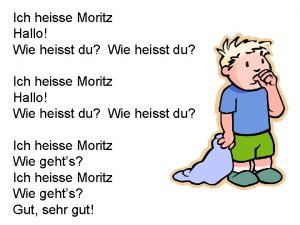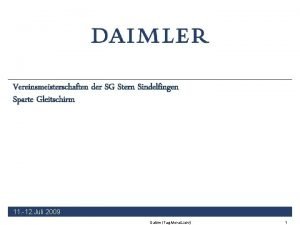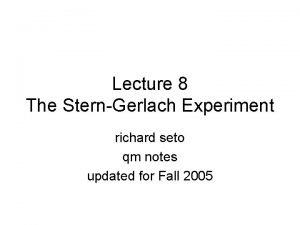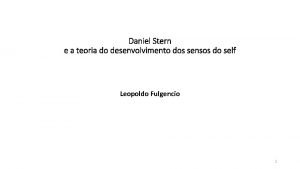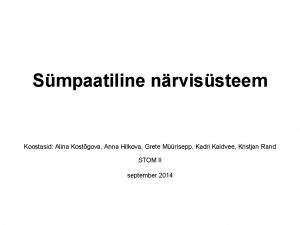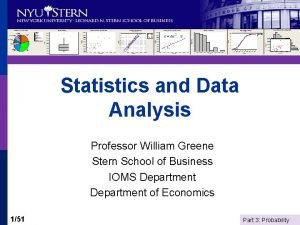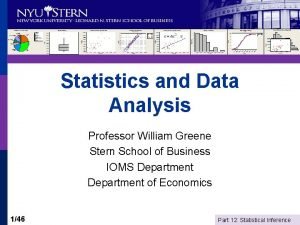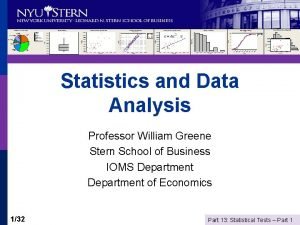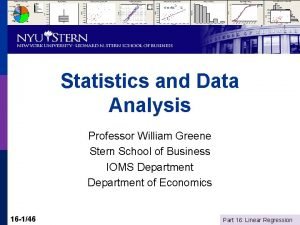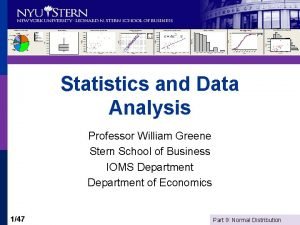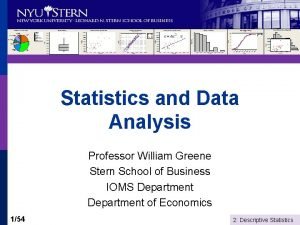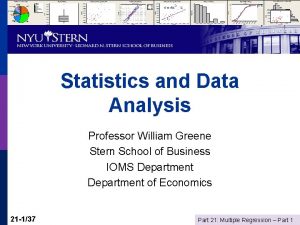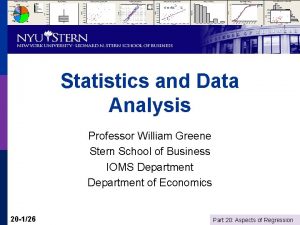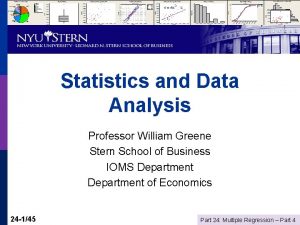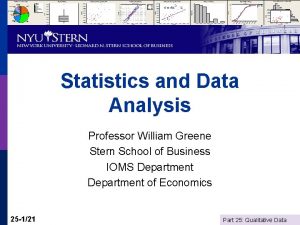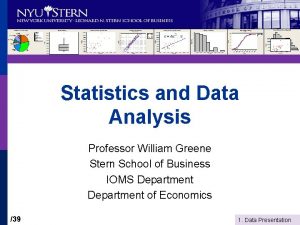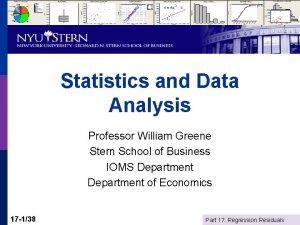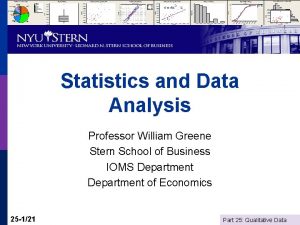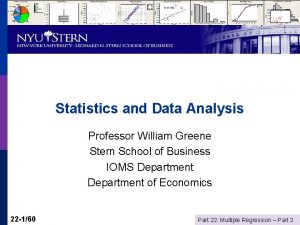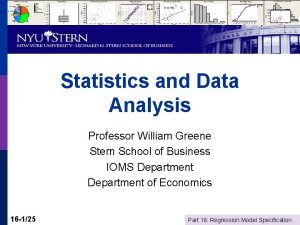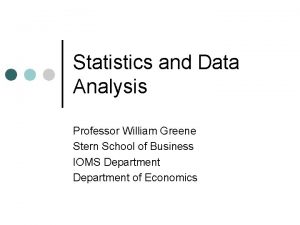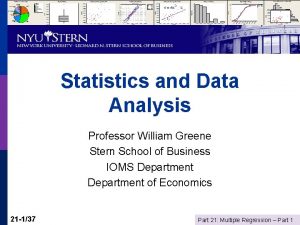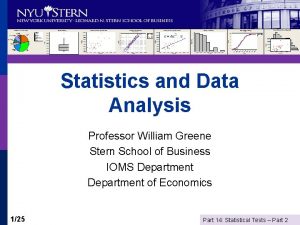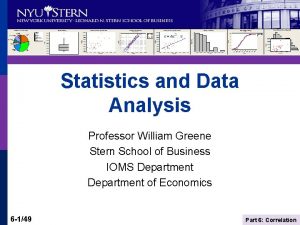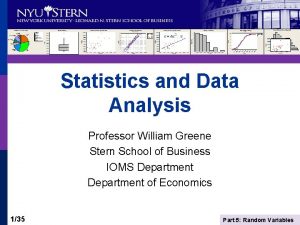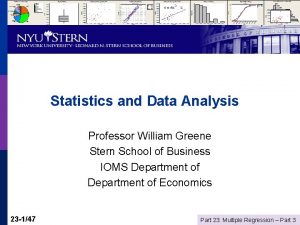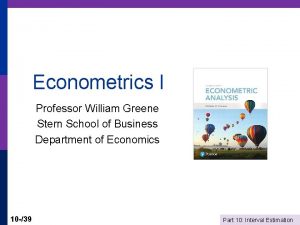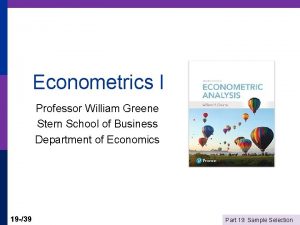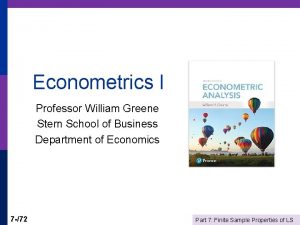Statistics and Data Analysis Professor William Greene Stern
























![Variance = E[X – μ]2 = σ2 (sigma 2) p Compute p The square Variance = E[X – μ]2 = σ2 (sigma 2) p Compute p The square](https://slidetodoc.com/presentation_image_h/a1ae3c91090d90dbcb759f2cfe57b9e1/image-25.jpg)





![A Possibly Useful “Shortcut” E[X – μ]2 = E[X 2] – μ 2 = A Possibly Useful “Shortcut” E[X – μ]2 = E[X 2] – μ 2 =](https://slidetodoc.com/presentation_image_h/a1ae3c91090d90dbcb759f2cfe57b9e1/image-31.jpg)

![Important Algebra Linear Translation: For the random variable X with mean E[X] = μ, Important Algebra Linear Translation: For the random variable X with mean E[X] = μ,](https://slidetodoc.com/presentation_image_h/a1ae3c91090d90dbcb759f2cfe57b9e1/image-33.jpg)











- Slides: 44

Statistics and Data Analysis Professor William Greene Stern School of Business IOMS Department of Economics 1/35 Part 5: Random Variables

Statistics and Data Analysis Part 5 – Random Variables 2/35 Part 5: Random Variables

Random Variable p Using random variables to organize the information about a random occurrence. p Random Variable: A variable that will take a value assigned to it by the outcome of a random experiment. p Realization of a random variable: The outcome of the experiment after it occurs. The value that is assigned to the random variable is the realization. X = the variable, x = the outcome 3/35 Part 5: Random Variables

Types of Random Variables p Discrete: Takes integer values n n p Continuous: A measurement. n n 4/35 Binary: Will an individual default (X=1) or not (X=0)? How many messages arrive at a switch (customers at a service point) per unit of time? Finite: How many female children in families with 4 children; values = 0, 1, 2, 3, 4? Infinite: How many people will catch a certain disease per year in a given population? Values = 0, 1, 2, 3, … (How can the number be infinite? It is a model. ) How long will a light bulb last? Values X = 0 to ∞ Performance of financial assets over time How do we describe the distribution of biological measurements? Measures of intellectual performance Part 5: Random Variables

Modeling Fair Isaacs: A Binary Random Variable (Real) Sample of Applicants for a Credit Card Experiment = One randomly picked application. Let X = 0 if Rejected Let X = 1 if Accepted X is DISCRETE (Binary). This is called a Bernoulli random variable. Rejected 5/35 Approved The outcome is random from the credit card vendor’s point of view. Fair Isaacs uses a formula. Given the information on the application, the outcome is not random to Fair Isaacs. It is random to the vendor because they do not know the formula. Part 5: Random Variables

The Random Variable Lenders Are Really Interested In Is Default Of 10, 499 people whose application was accepted, 996 (9. 49%) defaulted on their credit account (loan). We let X denote the behavior of a credit card recipient. X = 0 if no default X = 1 if default This is a crucial variable for a lender. They spend endless resources trying to learn more about it. 6/35 Part 5: Random Variables

7/35 Part 5: Random Variables

Distribution Over a Count Of 13, 444 Applications, 2, 561 had at least one ‘derogatory report’ in the previous 12 months. Let X = the number of reports for individuals who have at least 1. X = 1, 2, …, >10. X is a discrete random variable. (There also about 9, 500 individuals in this data set who had X=0. ) 8/35 Part 5: Random Variables

Discrete Qualitative Random Variable Response (0 to 10) to the question: How satisfied are you with your health right now? Experiment = the response of an individual drawn at random. Let X = their response to the question. X = 0, 1, …, 10 This is a DISCRETE random variable, but it is not a count. Do women answer systematically differently from men? 9/35 Part 5: Random Variables

Continuous Variable – Light Bulb Lifetimes Probability for a specific value is 0. Probabilities are defined over intervals, such as P(1000 < Lifetime < 2500). Needs calculus. 10/35 Part 5: Random Variables

Lightbulb Lifetimes Distribution of T = the lifetime of the bulb. 10, 000 Hours? Philips Dura. Max Long Life “Lasts 1 Year” … “Life 1000 Hours. ” Exactly? Probability for a specific value is 0. Probabilities are defined over intervals, such as P(200 < Lifetime < 250). Needs calculus. 11/35 Part 5: Random Variables

Probability Distribution p p 12/35 Range of the random variable = the set of values it can take n Discrete: A set of integers. May be finite or infinite n Continuous: A range of values Probability distribution: Probabilities associated with values in the range. Part 5: Random Variables

Bernoulli Random Variable Probability Distribution P(X=0) P(X=1) 0. 5556 0. 4444 Experiment = A randomly picked application. Let X = 0 if Rejected Let X = 1 if Accepted The range of X is [0, 1] Reject 13/35 Approve Part 5: Random Variables

Probability Distribution Over Derogatory Reports X P(X=x) 1. 5100 2. 2085 3. 0953 4. 0547 5. 0430 6. 0226 7. 0148 8. 0125 9. 0109 10. 0277 14/35 Part 5: Random Variables

Notation 15/35 p Probability distribution = probabilities assigned to outcomes. p P(X=x) or P(Y=y) is common. p Probability function = PX(x). Sometimes called the density function p Cumulative probability is Prob(X < x) for the specific x. Part 5: Random Variables

Cumulative Probability Derogatory Reports X P(X=x) P(X<x) 1. 5100 2. 2085. 7185 3. 0953. 8138 4. 0547. 8685 5. 0430. 9115 6. 0226. 9341 7. 0148. 9489 8. 0125. 9614 9. 0109. 9723 10. 0277 1. 0000 16/35 Part 5: Random Variables

Rules for Probabilities 1. 0 < P(x) < 1 (Valid probabilities) 2. 3. For different values of x, say A and B, Prob(X=A or X=B) = P(A) + P(B) 17/35 Part 5: Random Variables

Probabilities Derogatory Reports X P(X=x) P(X<x) 1. 5100 2. 2085. 7185 3. 0953. 8138 4. 0547. 8685 5. 0430. 9115 6. 0226. 9341 7. 0148. 9489 8. 0125. 9614 9. 0109. 9723 10. 0277 1. 0000 18/35 P(a < x < b) = P(a)+P(a+1)+…+P(b) E. g. , P(5 < Derogs < 8) =. 0430 +. 0226 +. 0148 +. 0125 =. 0929 P(a < x < b) = P(x < b) – P(x < a-1) E. g. , P(5 < Derogs < 8) = P(Derogs < 8) – P(Derogs < 4) =. 9614 -. 8685 =. 0929 Part 5: Random Variables

Mean of a Random Variable p Average outcome; outcomes weighted by probabilities (likelihood) p Typical value Usually not equal to a value that the random variable actually takes. n E. g. , the average family size in the U. S. is 1. 4 children. p p Usually denoted E[X] = μ (mu) 19/35 Part 5: Random Variables

Expected Value X = Derogs x P(X=x) 1. 5100 2. 2085 3. 0953 4. 0547 5. 0430 6. 0226 7. 0148 8. 0125 9. 0109 10. 0277 μ=2. 361 E[X] = 1(. 5100) + 2(. 2085) + 3(. 0953) + … + 10(. 0277) = 2. 3610 20/35 Part 5: Random Variables

Expected Payoffs are Expected Values of Random Variables p p 18 Red numbers 18 Black numbers 2 Green numbers (0, 00) 21/35 Bet $1 on a number If it comes up, win $35. If not, lose the $1 The amount won is the random variable: Win = -1 P(-1) = 37/38 +35 P(+35) = 1/38 E[Win] = (-1)(37/38) + (+35)(1/38) = -0. 053 = -5. 3 cents (familiar). Part 5: Random Variables

Buy a Product Warranty? Should you buy a $20 replacement warranty on a $47. 99 appliance? What are the considerations? Probability of product failure = P (? ) Expected value of the insurance = -$20 + P*$47. 99 < 0 if P < 20/47. 99. Expected value of the warranty is negative if P < 0. 42. 22/35 Part 5: Random Variables

Median of a Random Variable The median of X is the value x such that Prob(X < x) =. 5. For a continuous variable, we will find this using calculus. For a discrete value, Prob(X < M+1) >. 5 and Prob(X < M-1) <. 5 X 0 1 2 3 4 5 6 7 8 9 10 Prob(X=x) Prob(X < x). 0164. 0093. 0257. 0235. 0492. 0429. 0921. 0509. 1430. 1549. 2979. 0926. 3905. 1548. 5453. 2259. 7712. 1120. 8832. 1168 1. 0000 Mean (6. 8) Median (7) Health Satisfaction Sample Proportions. 23/35 Part 5: Random Variables

Measuring the “Spread” of the Random Outcomes Derogatory Reports X P(X=x) 1. 5100 2. 2085 3. 0953 4. 0547 5. 0430 6. 0226 7. 0148 8. 0125 9. 0109 10. 0277 μ=2. 361 24/35 The range is 1 to 10, but values outside 1 to 5 are rather unlikely. Part 5: Random Variables
![Variance EX μ2 σ2 sigma 2 p Compute p The square Variance = E[X – μ]2 = σ2 (sigma 2) p Compute p The square](https://slidetodoc.com/presentation_image_h/a1ae3c91090d90dbcb759f2cfe57b9e1/image-25.jpg)
Variance = E[X – μ]2 = σ2 (sigma 2) p Compute p The square root is usually more useful. p Standard deviation = σ n Compute n 25/35 Part 5: Random Variables

Variance Computation X = Derogatory Reports. μ = 2. 361 x P(X=x) x-μ (x- μ)2 P(X=x)(x-μ)2 1. 5100 -1. 361 1. 85232 0. 94468 2. 2085 -0. 361 0. 13032 0. 02717 3. 0953 0. 639 0. 40832 0. 03891 4. 0547 1. 639 2. 28632 0. 14694 5. 0430 2. 639 6. 96432 0. 29947 6. 0226 3. 639 13. 24232 0. 29928 7. 0148 4. 639 21. 53032 0. 31850 8. 0125 5. 639 31. 79832 0. 39748 9. 0109 6. 639 44. 07632 0. 48043 10. 0277 7. 639 58. 35432 1. 61641 SUM 4. 56928 26/35 σ2 = 4. 56928 σ = 2. 13759 Part 5: Random Variables

Common Results for Random Variables p Concentration of Probability n n n p What it means: For any random outcome, n n n 27/35 For almost any random variable, 2/3 of the probability lies within μ ± 1σ For almost any random variable, 95% of the probability lies within μ ± 2σ For almost any random variable, more than 99. 5% of the probability lies within μ ± 3σ An (observed) outcome more than one σ away from μ is somewhat unusual. One that is more than 2σ away is very unusual. One that is more than 3σ away from the mean is so unusual that it might be an outlier (a freak outcome). Part 5: Random Variables

Outlier? 28/35 p In the larger credit card data set, there was an individual who had 14 major derogatory reports in the year of observation. Is this “within the expected range” by the measure of the distribution? p The person’s deviation is (14 – 2. 361)/2. 138 = 5. 4 standard deviations above the mean. This person is very far outside the norm. Part 5: Random Variables

Application: Sharpe Ratio 29/35 Part 5: Random Variables

Recall from day 2 of class Reliable Rules of Thumb p p p 30/35 Almost always, 66% of the observations in a sample will lie in the range [mean+1 s. d. and mean – 1 s. d. ] Almost always, 95% of the observations in a sample will lie in the range [mean+2 s. d. and mean – 2 s. d. ] Almost always, 99. 5% of the observations in a sample will lie in the range [mean+3 s. d. and mean – 3 s. d. ] Part 5: Random Variables
![A Possibly Useful Shortcut EX μ2 EX 2 μ 2 A Possibly Useful “Shortcut” E[X – μ]2 = E[X 2] – μ 2 =](https://slidetodoc.com/presentation_image_h/a1ae3c91090d90dbcb759f2cfe57b9e1/image-31.jpg)
A Possibly Useful “Shortcut” E[X – μ]2 = E[X 2] – μ 2 = 31/35 Part 5: Random Variables

Application 32/35 Part 5: Random Variables
![Important Algebra Linear Translation For the random variable X with mean EX μ Important Algebra Linear Translation: For the random variable X with mean E[X] = μ,](https://slidetodoc.com/presentation_image_h/a1ae3c91090d90dbcb759f2cfe57b9e1/image-33.jpg)
Important Algebra Linear Translation: For the random variable X with mean E[X] = μ, if Y = a+b. X, then E[Y] = a + bμ p Scaling: For the random variable X with standard deviation σX, if Y = a+b. X, then σY = |b| σX p 33/35 Part 5: Random Variables

Example: Repair Costs p p 34/35 The number of repair orders per day at a body shop is distributed by: Repairs 0 1 2 3 4 Probability. 1. 2. 35. 2. 15 Opening the shop costs $500 for any repairs. Two people each cost $100/repair to do the work. What are the mean and standard deviation of the number of repair orders? μ = 0(. 1) + 1(. 2) + 2(. 35) + 3(. 2) + 4(. 15) = 2. 10 2 2 2 2 σ = 0 (. 1) + 1 (. 2) + 2 (. 35) + 3 (. 2) + 4 (. 15) – 2. 1 = 1. 39 σ = 1. 179 What are the mean and standard deviation of the cost per day to run the shop? Cost = $500 + $100*(2)*(Number of Repairs) Mean = $500 + $100*(2)*(2. 1) = $920/day Standard deviation = $100*(2)*(1. 179) = $235. 80/day Part 5: Random Variables

Summary p p p 35/35 Random variables and random outcomes n Outcome or sample space = range of the random variable n Types of variables: discrete vs. continuous Probability distributions n Probabilities n Cumulative probabilities n Rules for probabilities Moments n Mean of a random variable n Standard deviation of a random variable Part 5: Random Variables

Application: Expected Profits and Risk You must decide how many copies of your self published novel to print. Based on market research, you believe the following distribution describes X, your likely sales (demand). x P(X=x) 25. 10 (Note: Sales are in thousands. Convert your final result to 40. 30 dollars after all computations are done by multiplying your 55. 45 final results by $1, 000. ) 70. 15 Printing costs are $1. 25 per book. (It’s a small book. ) The selling price will be $3. 25. Any unsold books that you print must be discarded (at a loss of $2. 00/copy). You must decide how many copies of the book to print, 25, 40, 55 or 70. (You are committed to one of these four – 0 is not an option. ) A. What is the expected number of copies demanded. B. What is the standard deviation of the number of copies demanded. C. Which of the four print runs shown maximizes your expected profit? Compute all four. D. Which of the four print runs is least risky – i. e. , minimizes the standard deviation of the profit (given the number printed). Compute all four. E. Based on C. and D. , which of the four print runs seems best for you? 36/35 Part 5: Random Variables

37/35 Part 5: Random Variables

38/35 Part 5: Random Variables

39/35 Part 5: Random Variables

Expected Profit Given Print Run 40/35 Part 5: Random Variables

41/35 Part 5: Random Variables

Run=70, 000 Run=55, 000 Run=40, 000 Run=25, 000 42/35 Part 5: Random Variables

Run=70, 000 is inferior to 40, 000 Run=55, 000 Run=40, 000 Run=25, 000 43/35 Part 5: Random Variables

Which of these choices would you prefer? 25, 000 is safe, but an extremely risk averse choice and has far lower expected payoff than 40 or 55. Run=55, 000 Run=40, 000 Run=25, 000 44/35 Part 5: Random Variables
 Aft end
Aft end Promotion from associate professor to professor
Promotion from associate professor to professor Kylie greene
Kylie greene The tenth man graham greene summary
The tenth man graham greene summary Stoke's theorem gives the relation between
Stoke's theorem gives the relation between Destructors graham greene
Destructors graham greene Adaptive challenges examples
Adaptive challenges examples Heart of darkness
Heart of darkness Robert greene shakespeare
Robert greene shakespeare Arin greene
Arin greene Linda r greene
Linda r greene Problem solving plan (plan b flowchart)
Problem solving plan (plan b flowchart) Adult expectations
Adult expectations Maxine greene releasing the imagination
Maxine greene releasing the imagination Ericka simpson md
Ericka simpson md Eric greene course
Eric greene course Auditory digital
Auditory digital Uzuri pease-greene
Uzuri pease-greene Robin dunkin ucsc
Robin dunkin ucsc Introduction to statistics what is statistics
Introduction to statistics what is statistics Essential statistics william navidi pdf
Essential statistics william navidi pdf William navidi elementary statistics pdf
William navidi elementary statistics pdf Essential statistics william navidi pdf
Essential statistics william navidi pdf William navidi essential statistics pdf
William navidi essential statistics pdf Barry navidi
Barry navidi Personal network analysis
Personal network analysis Stern utvecklingspsykologi
Stern utvecklingspsykologi Stern village trumbull ct
Stern village trumbull ct Sea transport solutions stern landing vessel
Sea transport solutions stern landing vessel Dr theodore stern
Dr theodore stern Starboard and port side
Starboard and port side Experimento de stern-gerlach
Experimento de stern-gerlach Bow stern port starboard
Bow stern port starboard Poliengine reviews
Poliengine reviews Ich heisst du
Ich heisst du Ady stern
Ady stern Daniel stern model
Daniel stern model Sg stern sindelfingen
Sg stern sindelfingen Howard stern allison
Howard stern allison Race and resettlement act schindler's list
Race and resettlement act schindler's list Ben kingsley som itzak stern
Ben kingsley som itzak stern Stern-gerlach experiment lecture notes
Stern-gerlach experiment lecture notes Stern teoria
Stern teoria Grete stern
Grete stern Scott mutter escalator
Scott mutter escalator









